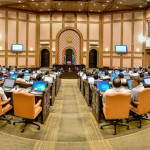Residents of Noonu atoll Holhudhoo have sent a letter to their island councillor expressing concern over the escalation in beach erosion, especially as monsoon season approaches.
Councillor Ishaq Rasheed told Minivan News that erosion was particularly bad on the north-east corner of the island where land had been reclaimed and plots given out to islanders to build houses.
“It happens every year during the north-east monsoon but it was worse last year than before,” said Ishaq, adding that he feared a repeat in late December or early January.
“One house owned by Badeeu was almost built. He just had the foundations. But luckily he didn’t built it otherwise it would have been completely in the sea,” he said.
In another example, Ishaq said the occupants of Saraamanzil were forced to leave their house on several occasions “because the sea is almost up to its walls”.
He said that although the President had pledged to build a sea wall, the government was still awaiting loan assistance for the Rf2 million (US$156,000) project.
For now, he continued, residents with homes on the north-eastern corner of the island would have to be relocated when the weather worsened.
As one of the lowest-lying countries in the world, the Maldives is particularly vulnerable to rising sea levels and its corollary, beach erosion.
In 2007, the United Nations Intergovernmental Panel on Climate Change predicted sea level rise of between 18cm and 59cm within the next century would submerge many of the Indian Ocean nation’s islands.
Speaking to Minivan News, Abdulla Shahid, chief coordinator at the disaster management centre, said that no action had been taken to tackle Holhudhoo’s erosion problem yet.
“The main reason is budget difficulties,” said Shahid, who added that over 70 per cent of islands in the Maldives experienced beach erosion.
If budget was not a question, Shahid said he would like to acquire the technical know-how and assistance to build bespoke harbours for each of the islands.
“This is what’s causing these problems. There might be other issues related to climate change but most of these erosion problems are related to harbours,” he said.
The Maldives’ “cut and paste” harbours have been criticised for not taking an island’s specific attributes, such as sand movement, into consideration, resulting in erosion.
Although islands in the Maldives are dynamic and coastal erosion is counterbalanced by subsequent sand accretion, erosion is worsened by man-made activity such as ill-conceived harbours.
Shahid said he was seeking cooperation with other countries such as the United States and the United Kingdom, which had experience of designing and building harbours.
Until then, he said, sandbags provided a temporary measure, adding that the disaster management centre had recently sent 1,200 sandbags to Raa atoll Dhuvafaaru to help with the problem.
“We have got our work cut out and we have got nothing but empty coffers,” he said.





